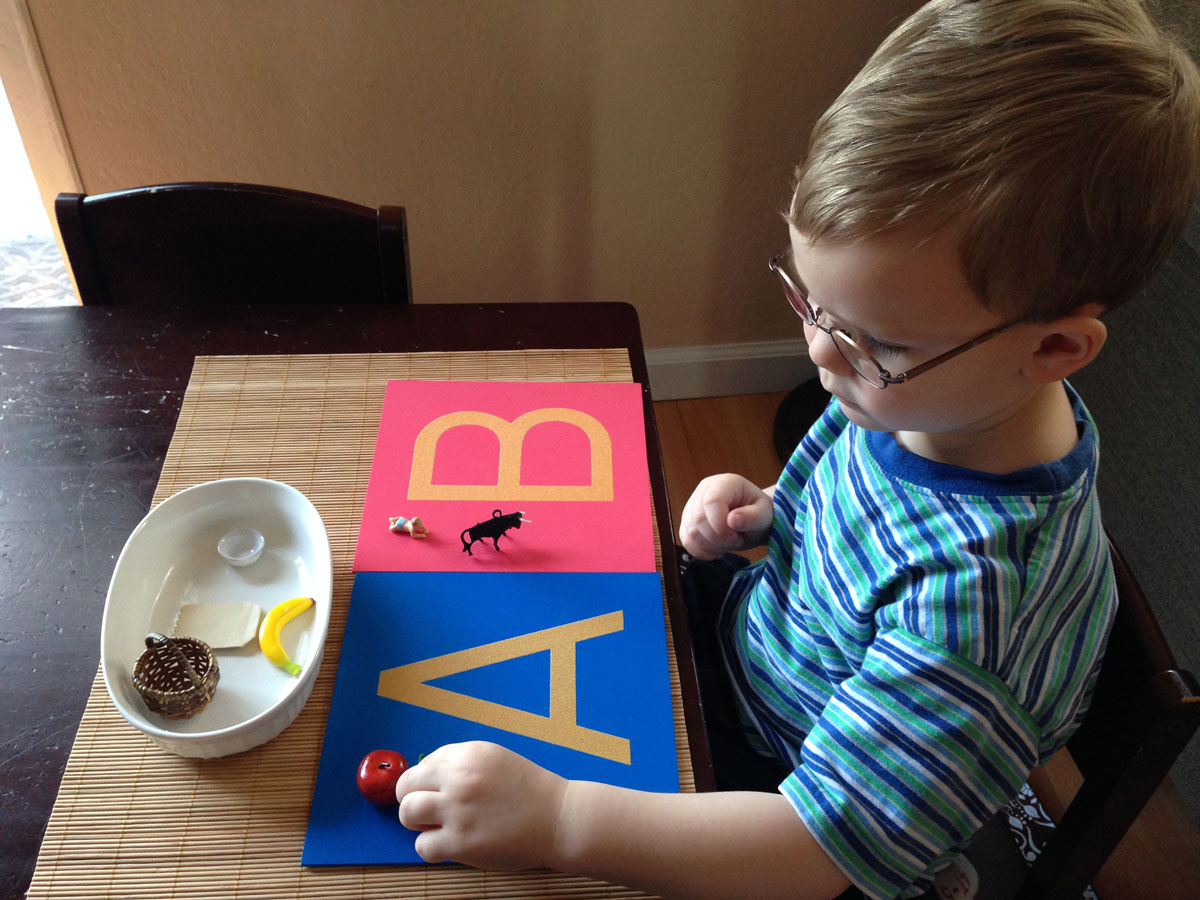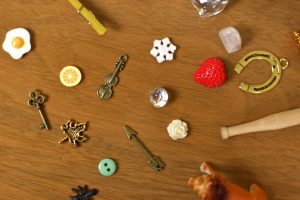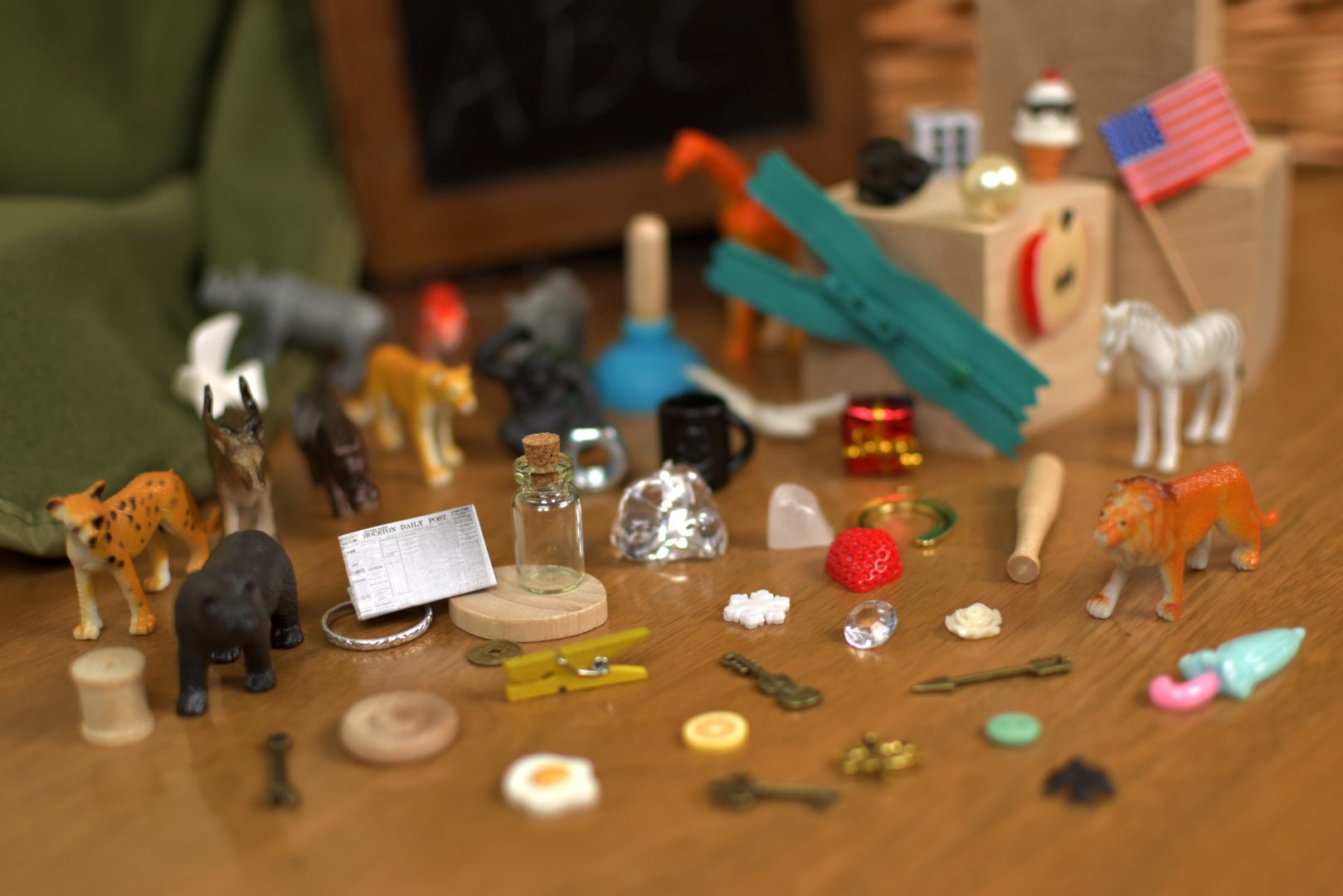Beginning Sounds with Language Miniatures
Children are said to be like sponges—primed and ready to absorb information and skills. My three children are sponges, but not the calm, inanimate sponges on my kitchen sink. They’re more like spinning, bouncing, and giggling sponges who want to interact with their environments. This sponge-like quality is the basis of what Maria Montessori called the absorbent mind. With this understanding, Montessori designed materials that would help children effortlessly absorb knowledge from their environment. Montessori language miniatures are one example of such materials. In this article, we’ll break down how children can learn beginning sounds with language miniatures.
What Are Montessori Language Miniatures?
Montessori language miniatures are small objects or figurines used to practice language skills. An example of a Montessori language miniature is a small ant figurine used to represent the sound “ah.” Sets of language miniatures are available for purchase, such as these Montessori language miniatures from Montessori By Mom. Educators and parents can also assemble their own sets. It is important to consider age recommendations for miniature sets since small objects pose a choking hazard.
Language miniatures are a valuable tool for learning beginning sounds, which are the initial sounds in words. For example, “buh” is the beginning sound in bat, ball, and book. The sound “muh” is the beginning sound of the words map and mud. Learning to identify words that have the same initial or beginning sound is part of phonological and phonemic awareness and is an important early reading skill.
Montessori Language Miniatures and Multisensory Learning
Twenty-first-century science substantiates what Montessorians have intuited for decades: activating a child’s senses improves learning. In her book “The Absorbent Mind,” Maria Montessori wrote, “The senses, being explorers of the world, open the way to knowledge.”
Multisensory learning engages more than one sense at a time and has been found to be a more effective way to teach and learn. The activated senses can include hearing, sight, touch, smell, and taste. Kinesthetic learning can also happen through body movement. Multisensory learning is a powerful teaching strategy for building reading skills. The involvement of multiple areas of the child’s brain can improve memory and literacy skills.
Language miniatures are a multisensory learning tool. Kids can pick them up and observe details, activating the senses of sight and touch. Educators can also activate kids’ auditory senses by making the beginning sounds associated with the objects. Importantly, language miniatures can interest little ones through hands-on activities. There are many ways kids can learn beginning sounds with language miniatures.
How to Use Montessori Language Miniatures to Teach Beginning Sounds
Montessori language miniatures can help kids learn beginning sounds through many different activities and games. Here are five simple and fun ways to use them to teach initial sounds:
1. Match language miniatures to beginning sounds.
One way to teach beginning sounds with language miniatures is to have children find the miniature that matches a beginning sound. To do this, the adult can lay out three language miniatures in front of the child and ask them to find the object that begins with a specific sound. For example, an adult can present a child with a rock, a button, and a kangaroo language miniature. The adult then asks, “Which starts with ‘buh’?” The child then successfully picks up the button. To make this activity more challenging, the adult can present more objects at a time.
2. Name what else starts with the beginning letter sound.
In this activity, the child is presented with a Montessori language miniature and asked to name something else that has the same beginning letter sound as the object. For example, the child may be given a turtle and asked to name something that starts with the same sound as the beginning sound in the word turtle. The child might say “top” or “tag” in response.
3. Grab the language miniature!
This activity is a friendly competition between two or three children. The adult presents a number of language miniatures and asks kids to quickly grab the object that corresponds to the beginning sound they hear. The adult makes the beginning sound, and the kids compete to grab the corresponding object first. The kid who grabs the most miniatures wins the game.
4. Match language miniatures to the letter.

In this activity, kids are asked to match language miniatures to the corresponding letters of the alphabet. Adults write the letters of the alphabet on paper or use sandpaper letters or movable alphabet letters. The children place the language miniatures with the letters that match their beginning sounds. For example, children may put a car next to the letter c.
5. Delete the beginning letter sound.
Adults can use language miniatures to help children learn how to remove the beginning sound in a word. For instance, they can ask the child, “Can you say ‘button’ without the ‘b’?” If the child is successful, they will say “utton.” This exercise helps children learn to break down words into different sounds and practice the skill of phoneme deletion.
The Potential of Montessori Language Miniatures
 Montessori language learning is a multi-faceted process that can begin at home during infancy with language, books, and music. Hands-on Montessori language tools, like sandpaper letters and the moveable alphabet, can also build language skills as children grow.
Montessori language learning is a multi-faceted process that can begin at home during infancy with language, books, and music. Hands-on Montessori language tools, like sandpaper letters and the moveable alphabet, can also build language skills as children grow.
Teaching beginning sounds with language miniatures is a great technique in Montessori environments. Importantly, language miniatures can be used for building many more skills, such as practicing rhyming, learning vocabulary words, and identifying ending sounds. There are many ways to use Montessori language miniatures to teach language. Language miniatures are a delightful and engaging tool that can grow with a child beyond learning beginning sounds!
Kelly Marie is a former scientist and mother of three young kids. She enjoys writing about her experiences in parenting and regularly creates free printable resources for parents and teachers for her blog Hey Kelly Marie. She currently lives in Kentucky with her family.





0 Comments